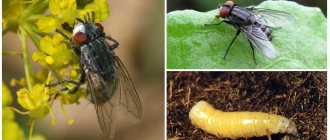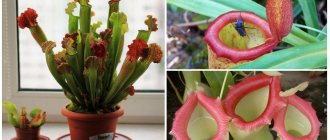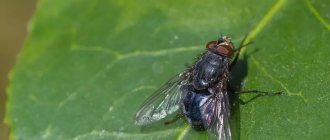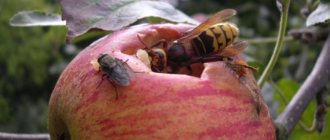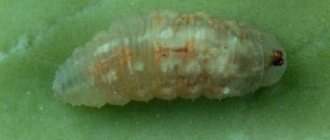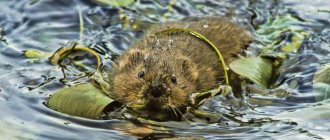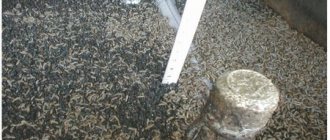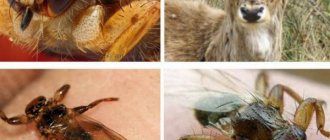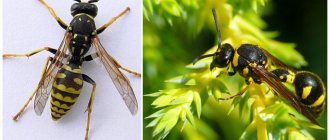Prevention and safety measures against flies
The basic rule of hygiene always remains in the first place, which concerns not only washing your hands, but also the proper handling of food before eating.
It is important to keep household items and utensils in proper condition. If food remains on the table in the summer, it must be covered with a special lid, mesh, or placed in an airtight container.
If flies enter the house, it is necessary to carry out special treatment using repellents. If an egg laying site is discovered, it must be thoroughly treated with chlorine-containing agents and chemical aerosols against these insects.
It is necessary to take care of the area where the garbage container is located - this area must be kept clean. Outdoor toilets must be equipped with special outlets for water flushing and basic cleaning of the premises. For barns and other premises intended for keeping livestock, there are special traps for winged pests. These are sticky tapes, hanging feeders with a sticky bottom that catch insects.
Follow basic hygiene rules, concentrate on the condition of products and methods of storing them, carry out the necessary treatment of premises from harmful arthropods - all this will help protect your home and the people living in it from discomfort and the danger of contracting infectious diseases. Wasps are famous for their bright colors, aggressive behavior, love of sweet foods and painful stings.
However, in nature there is an insect similar to a wasp, the characteristics of which are exactly the opposite. The only thing that connects him with the stinging creature is his appearance. Otherwise, it is a completely harmless and peaceful creation.
Wasps are famous for their bright colors, aggressive behavior, love of sweet foods and painful stings. However, in nature there is an insect similar to a wasp, the characteristics of which are exactly the opposite. The only thing that connects him with the stinging creature is his appearance. Otherwise, it is a completely harmless and peaceful creation.
A fly with a long black body and a sting
The wasp-like insect has a similar appearance to the ground wasp. The predator has a long black body and mustaches. The bug resembles a wasp due to its striped abdomen.
The black and yellow striped fly, like a wasp, is classified as a predator and easily attacks poisonous spiders. Found everywhere. Some representatives even inhabit the tropics. Some tropical species prefer human blood or mammals. They hide in shelters during the day and hunt at night. Distinctive features: extraordinary composure and the ability to watch over the victim for a long time.
The aggressor instantly rushes to attack, thrusts the sting and injects the toxin. The poison instantly paralyzes the victim.
Black and yellow striped fly
Similar behavior is found in the road wasp. The predator lays eggs on the body of the victim. The larvae pierce the abdomen of insects and gnaw out the insides. Before the cycle is completed, the remainder of the beetle or spider is only a bioshell.
Main differences from wasp
The wasp fly differs from dangerous pests:
- the presence of 1 pair of wings, a bee has 4;
- width and dimensions of the wings;
- hovering in the air and changing the direction of flight, thanks to reduced wings - halteres;
- the thinness of the limbs, on which pollen does not accumulate, compared to a bee;
- fine fluff instead of hard hairs on the body of syrphids, like those of a bumblebee;
- wasps belong to non-social insects; some individuals live separately and group only when mating.
blowfly
Blow flies get their name from their choice of animal carcasses as breeding grounds. Depending on the color of their back, they can be gray, green, or blue.
Gray blow flies
Gray blowflies are similar in appearance to regular houseflies, but are larger in size, although not always. While the housefly has four black stripes on its back, the gray blowfly has black spots in the form of stripes or checkers. The eyes, as a rule, like those of house flies, are bright red.
The name itself speaks about the inclinations of flies. They come in two colors: green and blue with a metallic sheen.
Unlike gray blowflies, carrion flies lay white eggs, looking for suitable carrion for them. The eggs hatch into smooth and hairy larvae. Hairy larvae are active predators; they eagerly eat smooth larvae that are born earlier. In about three weeks, the eggs will develop into adults, undergoing three molts during the larval stage and then pupating.
Types of flies, names and photographs
There are 3,650 species of flies in the world, some of which are particularly common:
house fly
a gray insect native to the Asian steppes. Distributed everywhere, most often near human habitation. Externally, many species are similar to the house fly, but it is distinguished by a special break at the edge of the wings. Under favorable conditions, the insect can live up to 2 months;
hoverfly (syrphid)
looks and habits similar to . The insect is distinguished by a black and yellow striped body and transparent wings. The hoverfly feeds on the nectar of flowering plants and is absolutely harmless. The fly got its name from the murmuring sound made by its wings when hovering;
green (carrion) fly
An insect with a shiny emerald body that lives near sewage and carrion. To avoid being eaten after mating, the male fly first offers the female some food;
common milkweed (tenacious) or bee-shaped milkweed
considered a subspecies of hover flies. A large insect, up to 1.5 cm long, with a dark-colored body covered with hairy pubescence. Beeworm larvae that enter the human body can cause serious intestinal disorders;
ktyr
a large predatory fly that poses a danger to midges, as well as similar flies. Killing various dangerous insects with a sharp sting and poison, tyri flies bring significant benefits to humanity;
Tsetse fly
inhabitant of the African continent. The main source of nutrition for this dangerous predator is the blood of wild mammals, as well as livestock and people. Tsetse flies are carriers of trypanosomes, which cause an incurable disease that destroys the immune and nervous systems and leads to death.
Tsetse fly. Alan R Walker, CC BY-SA 3.0
Harm from a murmuring fly
The daffodil fly, or the murmuring fly, causes great damage to the bulbs of daffodils, tulips, hyacinths, gladioli, and the rhizomes of irises.
Before winter, larvae that have not gone through three stages of development are buried in the ground near bulbous plants and overwinter in the bulbs. They eat away the inside of the bulb, and if the plant does not die, then in the spring it grows extremely slowly and does not bloom.
The pest does not like peat, so one of the methods of plant protection is to mulch the planting with peat.
Infected plants can be watered with a solution of pine flour powder, and it is recommended to heat-treat the planting material during the washing and drying process.
Drosophila fly
The Drosophila fly turned out to be much more convenient for scientific research into gene behavior than Pavlov's dog. Today this fly is one of the living organisms most studied by man. The development of the chromosomal theory of heredity and sex genetics owes to this fly. Its short life cycle, small size of the insect, and ease of reproduction have made the fly a model object for genetic research.
In the wild, Drosophila fly larvae develop in vegetables and fruits, for which they are also called fruit flies. Sometimes they choose fungi or decaying remains of plants and microorganisms for development. Adults feed on plant sap, rotting fruits and vegetables.
housefly
The housefly is a synatropic insect, that is, it has connected its life with human habitation without becoming a domesticated pet. On the contrary, the person is very belligerent towards an uninvited travel companion. But a person cannot completely get rid of a housefly, although unlike cockroaches, the fly is diurnal.
Like all flies, it has large faceted dark red eyes and two pairs of wings. The second pair, called “haleteres,” helps maintain balance during very intricate flight trajectories. The fly has a “coat” of long, sparse hairs.
She loves a comfortable temperature and at plus twenty-five degrees Celsius she can live for twenty days if she manages not to get hit by a fly swatter. Flies are fertile. In winter they hibernate.
House flies are not able to bite through human skin, so they do not feed on blood, but finish eating after a person, and before eating they dilute solid food with their saliva
Benefits and harms of sirphides
These insects are not capable of causing direct harm to humans. Adults, pollinating plants, bring only benefits. They can even pollinate flowers that bees refuse. The syrphid's proboscis is longer than that of a bee. It's more difficult with larvae.
In some syrphid genera (Platycheirus, Syrphus, Melanostoma, Scaeva, Paragus, Sphaerophoria, Pipiza), the larvae are very useful, as they help fight pests. Others (Cheilosia, Merodon, Eumerus) themselves act as plant pests.
Short description
Flies belong to the order Diptera. Unlike other insects, they have only one pair of membranous wings. The movable head is quite large in size, and the oral apparatus is a special proboscis. The purpose of the hind wings is to regulate balance.
The special skeleton of these pests and strong muscles allow them to develop high speed in flight and stay in the air for quite a long time. In addition to natural flies, synanthropic flies, which exist near humans, are considered widespread. Among them, the most famous are, for example, true flies, blue, green and gray blowflies and hoverflies.
Features of house flies
These pests are prominent representatives of synanthropic insects - those whose life is connected with human habitation. People constantly struggle with this type of fly. There are many quite effective means for this, but it is not yet possible to get rid of insects once and for all. Unlike bedbugs and cockroaches, flies are exclusively diurnal.
What are blowflies?
These insects got their name because they breed on animal corpses. According to the color of the back, there are gray, green and blue blowflies. The appearance of gray pests resembles ordinary house flies. Adult females do not lay eggs. They immediately hatch the larvae, having previously selected a suitable place for them, which can be the decomposing body of an animal, fruit rot or manure.
Green (carrion) flies have a beautiful appearance, despite the fact that they are partial to carrion and various impurities. They feed on rotting organic matter, where females lay eggs - up to 200 at a time. The resulting larvae leave the carrion and hide in the soil to pupate. This stage lasts 1-2 weeks. After this time, an adult fly emerges from the surface.
What are hover flies?
However, not all flies are pests. Hover flies are very reminiscent of wasps - both in external characteristics and in their behavior. In summer, they can most often be seen near Asteraceae or umbelliferous plants. The body of the insect is covered with black and yellow stripes, and on the semicircular head there are large dark brown eyes. The diet of adults consists of flower nectar.
The female lays approximately 100–180 eggs at a time, so 2–4 generations of these insects can develop during the season.
Hover flies are beneficial insects because they destroy aphids, which cause irreparable damage to trees in the garden.
Some gardeners try to create all the conditions for flies of this species to breed in their areas. To do this, they specially plant umbrella plants, such as carrots, dill or parsley.
Large striped fly
Syrphids, or hoverflies, represent a family of 6,000 species. Outwardly they resemble bees, wasps, and bumblebees. Widely distributed in all regions except Antarctica, desert and tundra zones. The characteristic sound that the wings make is the basis for the name.
The wasp-like fly is distinguished by its harmlessness to humans. It is often observed in vegetable beds with carrots, dill, celery, and parsley. The diet of adult syrphids consists only of flower nectar and pollen. They belong to pollinating insects.
Feeding of syrphid larvae
Hoverfly larvae look like small leeches. The wrinkled body has a green or yellowish color. Mobility is not typical for legless individuals. Meals include:
- spider mite;
- oviposition of parasites;
- aphid.
Physical activity is developed only when hunting aphids. The hoverfly rises, sways from side to side, quickly attacks the victim, and absorbs it. Then, in search of food, the larva moves, trying to roll its body weight.
For your information. Flies, similar to bees, have a beneficial effect on agricultural areas.
The basis of the sirfid menu is plant nectar sugar, which replenishes the insect’s energy reserves. The primary source of protein is pollen, which is required for the proper development and growth of eggs.
The attentive mother hoverfly lays her eggs directly into the aphid nursery.
The period of development of murmuring larvae ranges from 15 to 20 days. The gluttony of young animals is amazing: by the end of their growth they eat up to 200 aphids, destroying about 2000 small insects during their existence.
Note! Syrphid larvae feed not only on plant tissues - the diet of exotics includes processed wood or manure products.
Reproduction
The flight of flies with the wasp color occurs in the last ten days of May - the first days of June. In the middle of the summer season, the mating season of insects occurs. One individual lays up to 200 eggs:
- in grass;
- on the branches of crops;
- on the ground surface.
The location of the masonry is determined by the type of hoverflies. The eggs develop within 8-12 days. Sedentary larvae without legs resemble a greenish, light yellow or pink leech. The thin skin allows you to view the internal organs. At this stage, the hoverfly reaches 1 cm in length.
Depending on the food, the larvae are divided into:
- larvae that live in water bodies are detritus;
- predators that feed on fleas, aphids, and small pests, helping summer residents in the fight against parasites;
- herbivorous species that damage lily bulbs and flower stalks of crops;
- manure and wood from dead trees, which exotic syrphid flies cannot do without.
How to protect yourself from harmful insects
The main rule that must be followed in order to protect the area from large concentrations of flies is ideal cleanliness. You can also use the following preventive measures:
- Plant a walnut tree in the yard, as flies cannot stand its smell.
- Castor beans, currants and bird cherry repel flies well.
- In multi-storey buildings, areas that are located in close proximity to the garbage chute must be regularly treated with disinfectants.
- Since flies do not like the smell of vinegar, it is advisable to lubricate windows and doors indoors with the solution.
- Floors pre-treated with turpentine mastic are good at repelling flies.
- It is advisable to ventilate the room as often as possible.
Fly larvae found in cesspools or temporary latrines can be destroyed using disinfectants, which should be poured into them several times a month.
Fly like a wasp
Hoverflies (lat. Syrphidae) are often found in vegetable gardens and summer cottages, where they actively pollinate flowers on garden and fruit crops.
They are widespread and are found on all continents at positive air temperatures. According to biological classification, scientists place them in the order of short-whiskers and the family of Diptera.
Syrphids use a remarkable ability for mimicry, having an appearance very similar to the stinging insects of bees and wasps, having the same yellow and black striped abdomen, as seen in the photo of the hoverfly, thanks to which they escape from the attacks of birds and predators. Hoverflies are virtuosos in the “flight” business: their ability to hover or loiter in one place, and then break off and quickly fly away, is their distinctive feature. It is due to the unique structure of the wings: one pair is normal, and the second has been reduced over time into club-shaped halteres, which helps the insect maintain balance and control stopping in flight.
Male wasp flies have their own territory, which they vigilantly guard, periodically hovering in space. Even mating with females occurs in flight.
Externally, hoverflies resemble bees or wasps: they have an elongated body with a yellow belly and black stripes, some species have a black body with yellow spots.
Fly - description and characteristics
The body length of a fly can be from a few millimeters to 2 cm. The insect has a pair of membranous wings, a rather large head, endowed with an oral organ - a proboscis, designed for sucking up liquid food. The fly's body consists of three parts: head, abdomen and chest, ending with three pairs of legs. Each leg of a fly is divided into five segments. One part is the foot, with two sharp claws and sticky pads. This feature allows the fly to quickly move along the ceiling and any vertical surfaces.
The eyes of a fly are a unique organ. Thanks to several thousand hexagonal facets, the fly has a circular field of vision, so its huge eyes can easily simultaneously see everything that happens to the side and even behind. The organ of smell is the antennae, which can recognize odors at great distances.
What you need to know about flies
There are more than 4 thousand species of this insect in the world. All of them, without exception, can cause discomfort and cause some harm to humans, but their role is important in the food chain of many animals and especially birds. In the territory of the former CIS, exophilic and endophilic flies are most often found. Both of them can live in a person’s home, causing considerable discomfort.
For example, in the Wohlfarth fly, which we are used to seeing near agricultural buildings, the larvae are carnivorous, and in the most advanced cases they can lead to disability. Green, shiny flies are no less dangerous; they are called meat flies.
Tahina is considered to be such a species - this insect destroys caterpillars in gardens and fields. But the ktyr, with its sharp sting and poison, destroys mosquitoes, midges and other blood-sucking insects. There are blood-sucking representatives of the genus Diptera, which cause certain harm to people and animals. They are called bloodsuckers of horses, dogs and deer. The bite of such individuals cannot go unnoticed - the fly digs its sharp proboscis into the body and drinks blood. Their larvae, accordingly, are carnivorous and require a living organism as a home for development.
The developmental stages of these arthropods are fleeting; in literally 15-20 days, the fly turns from an egg into an adult, capable of laying new eggs. It is worth saying that in one clutch it is capable of producing from 100 to 150 eggs. Fly larvae appear on the fifth day from small white eggs, the size of which is no more than 1.2 mm. After a week, these white worms change their appearance and turn into a kind of pupa. Their skin takes on a dark brown color and becomes significantly rougher, which provides protection for the insect while it is inside. After 10 days, an adult emerges from the pupa, which is able to begin mating and after 2-3 days lay new eggs.
The fly can lay larvae anywhere - it can be manure, food or lost food, garbage, or even a wound on the animal’s body. It all depends on the type of dipteran and its mode of life. The fly larvae, hoverflies, are capable of eating more than 2 thousand aphids over the entire period of their development.
Larva
Adult insects appear in the garden towards the end of spring. Wasp flies mate in midsummer. They fly actively until the beginning of August. Each female syrphid lays up to 200 white eggs. She leaves them on grassy areas, plant stems, soil or tree branches. It depends on the type of hoverfly.
Many people know what maggots (blowfly larvae) are. In the hoverfly, the larvae are also maggots, but their length does not exceed 10 mm.
The species of syrphid larvae affects their food preferences:
- predators - prefer aphids or grass fleas;
- herbivores - the basis of their diet is plant bulbs;
- aquatic - feed on dead organic matter;
- arboreal - prefer dead plant tissue, as well as excrement of farm animals.
Gradually, the grown larva of the hoverfly forms into a puparia. It is a false cocoon or molting skin of an adult larva. An adult insect matures inside the puparia. She stays in the cocoon for up to 2 weeks. Having flown out from the puparia, after 1-2 hours it spreads its wings and is ready for long flights.
Appearance
Adult flies reach a length of 3 to 13 mm, depending on the species. The fly's body is black or brown with stripes (or dots) of white or yellow covering the abdomen and/or thorax. Adult hover flies resemble small wasps. Their yellow or white and black striped abdomens serve to ward off predators. However, they can be distinguished from wasps by their single pair of wings, with vestigial hind wings as balancing organs. Syrphid fly larvae are mucus-like caterpillars that are wrinkled and narrowed at the front. Their color can be pink, yellow, green or brown, and they range in size from 4 to 18 mm in length.
Male and female flies
Like many other flies, males and females often look the same, have the same coloring, size, etc. However, it is always easy to tell the males from the females. Like all other flies, males have large eyes that come together at the top of the head. Females have much smaller eyes and are located further apart. The tiny eyes or sockets are made up of individual cells and are located on the top of the head in a triangle between the large compound eyes.
Differences between female and male Soaring Fly.
A more intrusive method of determining the sex of a babbling fly is to look at the underside of the abdomen; males have bridled, asymmetrical genitalia. The female's belly is pointed with inconspicuous genitalia.
Features of a slender wasp-like fly
When asked what the small, unusually slender striped fly is called, every biologist will answer: it is a hoverfly.
It belongs to the Diptera family of the short-whiskered suborder, which is very extensive - more than 6,000 species.
Most often you can find:
- the common hoverfly, which is also sometimes called the flower fly, its length is 12 mm, the insect is a good pollinator, and its larvae feed on garden pests;
- onion hoverfly, the main food of its larvae is the pulp and juice of bulbous plants;
- wasp-like - its appearance most closely resembles a wasp, and the larvae prefer rotten wood;
- tenacious beekeeper - this species resembles a bee and is darker in color, reaching 1.5 cm in length;
- the eristalia fly, its habitat is near water bodies, for which it was given the name aquatic hoverfly, the insect has a long proboscis that helps it breathe air;
- the bunched hoverfly wasp - in size and appearance it resembles a hornet, the food of the larvae is rotten wood;
- currant - its larvae feed on aphids;
- Ilnitsa - the insect can hover for a long time over reservoirs, at the bottom of which its larvae live.
Among these species there are those that are useful to humans, and there are also garden pests.
Appearance
The slender striped fly, called the hoverfly, looks like a wasp only at first glance.
Upon closer examination, there are many differences:
- only one pair of wings, whereas the wasp has two, although the second is much smaller;
- the golden body is also covered with stripes, but their shape is semi-lunar, black rings with clear boundaries, in most species of wasps the stripes have protrusions;
- the antennae, if any, are shorter in the striped fly;
- but compound eyes are much larger.
Why are these insects so similar? If for a wasp such a bright color is a warning about its danger, then the hoverfly is camouflaged in this way.
Not having such a formidable defense in the form of poison as a predator similar to it, it repeats its coloring for self-defense, escaping from enemies.
This phenomenon is called mimicry.
With its help, a striped fly, similar to a wasp, pretends to be it. In flight, the insect's wings make a special murmuring sound, for which it received the name hoverfly.
There are a huge number of species of syrphids - and this is another answer to the question of what the striped fly is called. They differ greatly from each other depending on their habitat.
Entomologists even have such a specialization - syrphidologist. Among the entire vast world of insects, they chose this unusually slender striped fly to study.
Life cycle and reproduction
The first adult flies appear in late spring, and mating occurs at the end of July. To lay eggs, the female chooses a place where the larvae will have plenty of food.
The further cycle of metamorphosis is as follows:
- egg, this stage lasts only three to four days;
- 1st stage larva;
- 2nd stage larva;
- stage 3 larva - they all look like maggots, gradually grow, reaching a length of about one centimeter, practically do not move, but are very voracious - they can easily eat up to 200 aphids per day;
- prepupa and pupa, their shell is called puparium and resembles a drop of resin, the period of stay in it is up to 2 weeks;
- imago, they are able to fly a couple of hours after emerging from the pupa.
During the development of the larva of some species of striped fly, up to 2000 insect pests become its prey.
Habitats and food
The striped hoverfly has colonized almost the entire territory of the earth's land. It's only too cold for her in Antarctica.
The habitats are very diverse and depend on the type of insect and the type of food that the larvae prefer.
Among the representatives of this family there are those whose larvae are herbivorous, and there are also predators among them. But this only applies to larvae.
All adults feed on pollen and nectar. The most preferred plants for them are complexly colored and umbrella plants, fruit bushes and trees.
Harm and benefits of the hoverfly
Most hoverflies are undoubtedly useful to humans. They not only pollinate plants in the absence of bees, their larvae free the garden and vegetable garden from pests.
Humans only have complaints about the onion hoverfly. Its larvae enjoy eating not only onions and garlic, but also bulbous flowers.
The harm from them can be very great.
In order not to lose the harvest, you will have to take measures:
- if the feathers turn yellow, the plant should be checked for the presence of larvae; if there are any, remove it and burn it;
- carry out treatment with insecticidal preparations;
- observe crop rotation;
- sow carrots and onions together; the hoverfly does not like the smell of carrots;
- After harvesting, disinfect the soil with a solution of copper sulfate.
When using chemicals, you need to be careful and take into account the harm they cause to beneficial insects.
Conclusion
The striped fly, similar to a wasp, is not capable of biting a person due to its biological structure.
On the contrary, the vast majority of species can become its allies in the fight against insect pests.
Experienced gardeners even recommend specially planting umbrella plants in places where pests may accumulate in order to attract these beneficial insects. This is much better than using pesticides.
Types of hoverflies
- Damaged plants should be immediately removed from the ground and burned.
- Treat the beds with insecticidal preparations Aktara, Decis, etc.
- Change the planting location of such flower crops every year.
- Plant carrots in the beds, because their smell can repel onion hoverflies and flies.
- according to the same recipe as for onion flies.
- It is good to loosen and mulch the soil to prevent compaction - this measure helps prevent the appearance of syrphids.
- To prevent the appearance of female onion hoverflies, it is recommended to treat the plantings with tobacco powder, ash, red pepper or mothballs.
- After harvesting beds with onions or garlic, it is recommended to treat the soil with copper sulfate.
However, most species of hoverflies are, helping to pollinate flowers and fruit crops in areas where there are few bees, and eating large quantities of small pests. Therefore, they are considered assistants to gardeners and flower growers, increasing plant productivity.
About harm and benefit
Not everyone knows that the hoverfly is not capable of biting, since it has neither a sting nor poison. Speaking about the harm and benefits of these “false” wasps, everything depends directly on their type.
The larvae of predatory hoverfly species are of great benefit. They are the best protectors of fruit trees and shrubs, destroying various harmful insects. Hoverfly larvae are also pollinators of flowering crops, which is especially necessary in mountainous areas due to the lack of bees.
Quite the opposite can be said about herbivorous hoverflies. Such flies are a source of great problems for owners of garden plots, causing damage to onions, garlic, hyacinth bulbs, daffodils, gladioli and tulips. As a result, damaged plants begin to hurt and dry out. The bulbs of flower crops suffer no less, not producing good reproduction.
What do fly larvae look like?
After maggots hatch from the eggs, they undergo certain changes over the course of 10-15 days. They are white-yellow or gray in color, with a small dark brown head equipped with two mouth hooks. The tail of such a worm is slightly rounded and has a depression - there are respiratory plates on it, and if you look closely, two dark dots are visible in this place. At a certain stage of its development, the maggot burrows deep into the soil and begins the process of forming a pupa.
It has an oval, oblong shape, color varies from dark brown to red-brown. An adult green fly climbs to the surface of the earth.
Life cycle and habitat
Like other flies, soaring flies go through all stages of insect life: egg, larva, pupa, imago (adult).
The life cycle of different species varies and depends on environmental conditions and the availability of food. Under optimal conditions, single white eggs are laid on leaves infested by pests or other suitable food sources. After hatching, approximately 3 days later, the larvae develop into 3 stages of growth into a pupa. If the pupa does not remain for the winter, adults emerge after 1-2 weeks. Up to seven generations can be born within a year.
Stages of development of the syrphid fly.
Water cycle of larval life
Some have adapted to aquatic life in dirty water (including stagnant water) by eating all types of decaying materials. In order to breathe, they expose a long tube at the rear end of their body to the surface of the water. Examples include rat-tail grubs (about 40 species).
Predatory larvae of the murmuring fly
Other larvae hunt for plant lice or aphids. More than a third of hovering flies have aphid-eating larvae (more than 110 species).
Carrion larvae
Some hover fly larvae live in rotting wood, or places where sap flows randomly from living trees (33 species).
Larvae pests of garden plants
Some larvae are agricultural pests, eating roots, stems, and the inside of flower bulbs (about 30 species).
A unique and secretive type of larvae that lives with ants
The larva of the hovering fly Doros profuges lives in the nests of the ant Lasius fuliginosus (Woodborer). There is no reliable information, but one guess is that the larvae either feed on root aphids that have been driven off by the ants, or receive some other benefit from living in their nest.
*if you have any thoughts, write your guess in the comments.
A fly that looks like a bumblebee
Bumblebee
Volucella, or bumblebee fly, or hoverfly, belongs to the subfamily Eristalinae of the genus of hoverflies.
The murmur is a migratory insect. Males are often territorial.
Bumblebee flies have a distinctive plume awn and a head that flares downward. Two black bands stand out on the hairy abdomen.
Bumblebees are bumblebee imitators that lay eggs in their nests. The appearance of an insect is often deceiving. The bumblebee fly, which peacefully collects pollen, is a merciless enemy of wasps. The larvae live in the hives of social wasps and bumblebees and feed on eggs, pupae, and adults. Some bumblebees feed on the remains of decomposed organic matter. Carrion larvae belong to the genus Vespula.
Interesting. A bumblebee-like larva sometimes crawls out of a wasp or bumblebee nest and climbs into a person’s home to find a cozy place for metamorphosis.
Volucella inanis is one of the species. The insect is called a devastating insect, but does not have a sting and feeds on nectar. The culinary preferences of the predatory insect are devouring the larvae of hornets, bumblebees, and wasps. The harmless fly is found in different regions of Russia.
On a note. Carl Linnaeus, a famous Swedish scientist, discovered and classified the devastating bumblebee in the 18th century.
Hoverfly family (Syrphidae)
Small or medium-sized flies (length 4-25 mm). Often black, with a metallic sheen of bronze, green or blue. Many other hoverflies are of a completely different color - with conspicuous yellow spots or bands. The shape and body color of such hoverflies are very similar to the color of many stinging Hymenoptera. Slightly pubescent forms resemble wasps, and hoverflies, covered with thick and long hairs, resemble bees and bumblebees. The similarity is further enhanced if the fly has long antennae, a stalked abdomen and a darkened anterior part of the wing.
There are about 6 thousand species in the world fauna, in Russia there are approximately 800 species. Flies feed on nectar and pollen; found in large numbers on flowering plants, especially umbrella plants. In terms of speed and maneuverability of flight, they occupy one of the first places in the world of insects. You can often observe how these flies hang motionless in the air for a long time, from time to time making rapid throws to the sides and just as instantly returning back. The larvae live in bodies of water of varying degrees of pollution (even drainage from livestock farms), in the nests of Hymenoptera, and in plant tissues; predatory forms live openly on plants, eating mainly aphids. They occupy one of the leading places among insect pollinators of plants. Herbivorous larvae, gnawing stems and bulbs, can harm cultivated plants.
Read: Buzz family (Bombyliidae)
On its abdomen there is a wide, light, almost transparent band. Body length 13-17 mm. The larvae of the transparent hoverfly develop in wasp nests, where they feed on the dead larvae of their hosts. Found almost everywhere.
Densely covered with hairs, this fly is very similar in color and pubescence to a bumblebee. The color is highly variable. Body length 11-15 mm. The larvae live in the nests of bumblebees and sometimes wasps, feeding on the larvae of the nest owners.
The lower part of the head of this fly, like all other species of this genus, is extended forward like a beak. Length 8-9 mm. The larvae develop in manure.
It resembles a bee in color and size (length 13-16 mm). Distributed everywhere (except for the Far North) and in some places found in large numbers. The larvae at the end of the abdomen have a very elongated and narrow respiratory tube, somewhat similar to a long tail, for which these and similar larvae of other species and genera of hoverflies received the name “rats.” They live in water, sometimes heavily polluted.
Read: Family of bloodsuckers (Hippoboscidae)
Body length 15-17 mm. Usually found in July-August, especially often on umbrella plants. The larvae live in damp dust in the hollows of deciduous trees.
This hoverfly has a very long abdomen, protruding beyond the ends of the wings for a considerable distance. Length 9-12 mm. The larvae live openly on plants, where they feed on aphids.
Danger and harm of bee fly larvae
Eristalis tenax, or milkweeds, are the larvae of the bee fly that live at the bottom of small and dirty ponds and lakes, puddles, and farm wastewater. To breathe, they float to the surface of the water and put out a long tube, which reaches up to 27 cm and is capable of decreasing and increasing. Because of their resemblance to the tail, beekeeper larvae are called rats.
The adult that hatches from the larva is the eristalia fly. It flies out in the autumn season and feeds on flower nectar.
In appearance and color it resembles a bee. The bee fly larva has an undeveloped head and no eyes. The underdeveloped mouth is covered with a fold. There are no legs, but growths are visible at the bottom of the body. The rat has 7 pairs of false legs: 6 on the abdomen and 1 on the chest. Thanks to them, the fly crawls. A two-centimeter cylinder with a long tube at the end, which allows it to live in polluted or oxygen-free waters.
When it’s time for pupation, the bee crawls out to the coast. It transforms into a pupa inside the larval skin.
A couple of centuries ago there was an opinion that bees were born from carrion. The reason for the myth was a rat that can live in rotten liquid and turn into a wasp fly.
Note! The rat signals water pollution. If rats appear in a pond, it is better to avoid swimming in dirty water.
The entry of bee larvae into the human body gives rise to accidental intestinal myiasis. Infection occurs when eggs of the pathogen are swallowed with food or eggs are laid by a fly in the anus, from where the larvae make their way into the rectum.
Bee fly larvae
Symptoms, diagnosis, therapy
Maturation of larvae in the intestines leads to the development of enteritis.
Its manifestations:
- abdominal pain and diarrhea;
- nausea and anal itching;
- insomnia and dizziness;
- lethargy.
Sometimes the disease is asymptomatic.
The disease is diagnosed through laboratory tests of stool. Treat with laxatives, metronidazole, nifuroxazide.
Eristalis tenax larvae can cause genitourinary myiasis or vulvar myiasis.
Pathology is registered in:
- Africa and India;
- Argentina and Iran;
- Australia and Chile;
- Brazil and European countries (Spain, Belgium, Denmark).
Hoverflies, or syrphids, can easily be confused with their stinging counterparts: a bee or a wasp. They are an important component of the biosphere. Flies clear the planet of plant debris and are unsafe for humans.
Question for experts:
Best regards, Vain Arson
